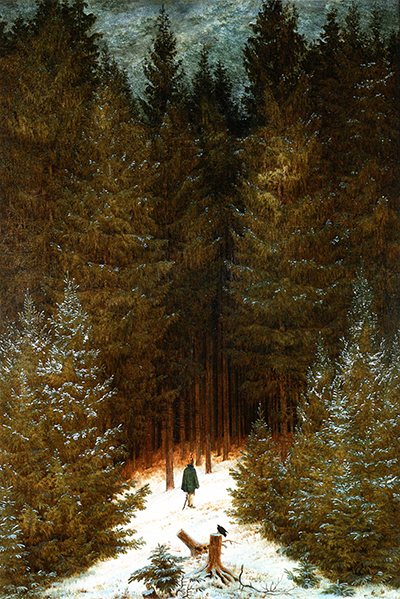Hunter in the Forest is a piece of noble art that was produced by a romantic gothic painter. He was widely known during his time just because of his ability to paint allegorical landscapes such as barren trees, medieval ruins, night skies, and morning mists. His painting Hunter in the forest was accomplished using oil on canvas. It is stored at a private collection for safeguarding and protection for future reference.
Friedrich is a renowned artist, and many people acknowledge his work Hunter in the Forest. And just like the many other paintings he had already done, this anti-classical work passes through a message that is subjective and emotional to the natural environment. Hunter, in the forest, was painted back in 1814 by this excellent expert. The artwork delivers a clear image with exceptional resolution and maximum color accuracy. The imagery shows a forest and a hunter in between the trees. There is also a crow just near the hunter. His primary technique in his artwork was painting, whereby he used oil to paint this particular art.
David started learning about art as a private learner under Johann Gottfried Quistorp, who was his mentor. He inspired him to start painting at an early age, and through him, David was able to meet with Ludwig Gotthard Kosegarten, who showed David that nature was some message from God. Friedrich was also inspired by Adam Elsheimer, who was an artist working mostly on religious subjects on nocturnal subjects and landscapes. He attended the Academy of Copenhagen, where he learned a lot under his mentor and teacher Jens Juel. Most of these artists during that time were inspired by a particular movement known as Sturm und Drang.
Other works by Caspar David Friedrich
- Old Heroes’ Graves. It was to act as a symbol of nationalism, and it involved tombs of fallen heroes as their spirits are seen freeing for eternity. Two French soldiers are seen before a cave as small figures.
- The Cross Beside The Baltic. This painting orchestrated Friedrich’s move from painting broad daylight paintings to nocturnal scenes and moody portraits.
- Moonrise Over The Sea. Approaching the 1820s, David’s paintings started having more and more human figures. Linda Siegel says that during this time, human life became crucial to Friedrich, especially his family. His friends were also seen to feature more as subjects in most of his artwork during this period.
- Graveyard Under Snow. This great artist sketched sculptures for mausoleums and memorial monuments, all showing how he was quite obsessed with death. That was mainly because he had encountered death at a tender age after most of his family members died when he was young.
- The Stages of Life. The artwork depicts a meditation by the artist. He was thinking and relaying his thoughts on his mortality. The drawing has five ships in different positions and distances from the beach. The foreground of the painting shows five figures that are at distinct stages of life.




